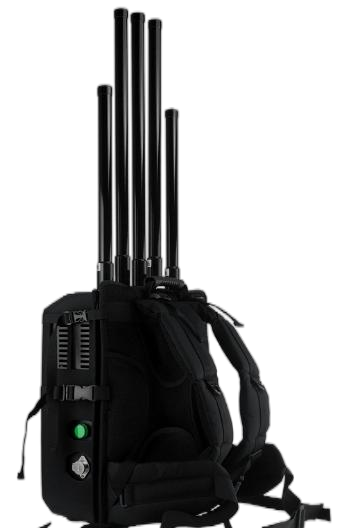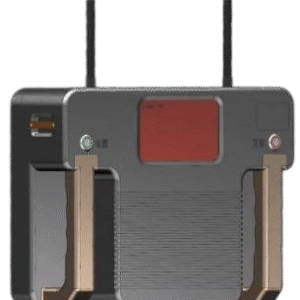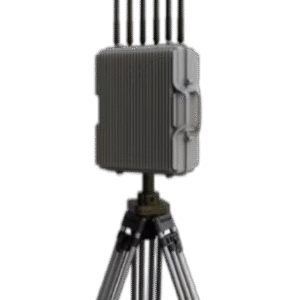Introduction: Evolution of Portable Electronic Warfare Systems in EOD Applications
The contemporary landscape of asymmetric threats necessitates sophisticated electronic countermeasure (ECM) solutions that combine operational mobility with comprehensive spectrum denial capabilities. The emergence of radio-controlled improvised explosive devices (RCIEDs) has fundamentally altered explosive ordnance disposal (EOD) operational paradigms, driving the development of specialized portable jamming systems. The TYFB-101 represents a significant advancement in man-portable electronic warfare technology, integrating broad-spectrum disruption capabilities within an ergonomically optimized platform designed for high-stress tactical environments.
This comprehensive analysis examines the technical architecture, operational deployment strategies, and performance characteristics of modern portable jamming systems, utilizing the TYFB-101 as an exemplar of current-generation ECM technology. Through comparative analysis and detailed technical exposition, we elucidate the critical role these systems play in contemporary security operations.
Technical Specifications: Comprehensive Performance Analysis
Table 1: TYFB-101 Core Technical Parameters
| Specification Category | Parameter Value | Operational Significance |
|---|---|---|
| Frequency Coverage | 27 MHz – 6000 MHz | Encompasses all commercial RF triggers |
| Effective Jamming Range | ≥60 meters | Tactical standoff distance |
| Power Output | Classified (Est. 50-100W total) | Optimized for portable operation |
| Antenna Configuration | Omnidirectional array | 360° protection sphere |
| Power Source | High-capacity Li-ion battery pack | Field-replaceable units |
| Operational Duration | ≥40 minutes (continuous transmission) | Extended mission capability |
| System Weight | <15 kg (estimated) | Ergonomic load distribution |
| Environmental Rating | MIL-STD-810G compliant | All-weather operation |
| Cooling System | Passive + forced convection | Thermal management |
Comparative Analysis: Portable vs. Stationary ECM Systems
| System Type | TYFB-101 (Portable) | Stationary ECM | Vehicle-Mounted |
|---|---|---|---|
| Mobility | High – Individual operator | None | Moderate – Road dependent |
| Coverage Area | 60m radius sphere | 500m+ radius | 200m radius |
| Power Consumption | Battery limited | Unlimited (mains) | Vehicle power |
| Deployment Time | <30 seconds | Hours/Days | Minutes |
| Operational Flexibility | Maximum | Minimal | Moderate |
| Cost per Unit | Moderate | High | Very High |
Applications: Operational Deployment Scenarios
Primary Mission Profiles
- Explosive Ordnance Disposal Operations
- RCIED neutralization during approach
- Safe corridor establishment
- Render-safe procedure protection
- Post-blast investigation security
- VIP Protection Details
- Mobile security bubble creation
- Route clearance operations
- Static position hardening
- Emergency evacuation coverage
- Special Operations Support
- Tactical entry protection
- Hostage rescue scenarios
- Counter-terrorism operations
- Covert insertion/extraction
Environmental Adaptation Capabilities
The TYFB-101’s design philosophy emphasizes operational versatility across diverse environments:
| Environment Type | Specific Adaptations | Performance Considerations |
|---|---|---|
| Urban | Multi-path propagation compensation | Building penetration optimization |
| Mountainous | Extended battery operation | Altitude compensation |
| Maritime | Corrosion-resistant components | Salt-spray protection |
| Desert | Enhanced thermal management | Dust infiltration prevention |
| Arctic | Low-temperature battery chemistry | De-icing protocols |
System Characteristics: Technical Architecture Deep Dive
Jamming Technology Implementation
The TYFB-101 employs a sophisticated multi-technique jamming architecture:
- Swept Continuous Wave (CW) Jamming
- Frequency agility: 1000 hops/second
- Bandwidth coverage: Adaptive spreading
- Power density optimization
- Barrage Noise Generation
- Broadband white noise synthesis
- Spectral power distribution control
- Adjacent channel protection
- Smart Jamming Protocols
- Threat library recognition
- Adaptive power allocation
- Selective frequency targeting
Antenna System Design
The omnidirectional antenna array incorporates advanced electromagnetic engineering:
Antenna Configuration:
- Ultra-wideband elements (27 MHz - 6 GHz)
- Circular polarization capability
- VSWR < 2:1 across operating range
- Gain pattern optimization for spherical coveragePower Management Architecture
Sophisticated power distribution ensures optimal performance:
| Subsystem | Power Allocation | Efficiency Measures |
|---|---|---|
| RF Amplifiers | 70% | Class E/F operation |
| Control Systems | 10% | Low-power processors |
| Cooling | 15% | Variable speed fans |
| Displays/Interface | 5% | OLED technology |
Regulatory Compliance: Legal Framework and Authorization
International Regulatory Standards
| Jurisdiction | Applicable Regulations | Authorization Requirements |
|---|---|---|
| NATO Countries | STANAG 4187 | Military exemption |
| United States | NTIA Manual, DoD Directive 3222.04 | Government use only |
| European Union | Council Decision 2014/415/CFSP | Law enforcement authorization |
| United Nations | Mine Action Standards (IMAS) | Mission-specific approval |
Operational Authorization Protocols
- Pre-Deployment Requirements
- Frequency deconfliction analysis
- Operational area clearance
- Emergency services notification
- Aviation authority coordination
- Documentation Requirements
- Mission authorization orders
- Frequency allocation certificates
- Operator qualification records
- Incident response protocols
Packaging and Logistics: Deployment Readiness
System Components and Configuration
| Component | Specifications | Ruggedization Standard |
|---|---|---|
| Main Unit | Backpack frame with integrated electronics | IP67, MIL-STD-810G |
| Battery Packs | 2x hot-swappable Li-ion modules | UN38.3 certified |
| Antenna Array | Collapsible omnidirectional system | Quick-release mounting |
| Control Panel | Ruggedized touchscreen interface | Glove-compatible operation |
| Accessories | Spare batteries, maintenance kit | Pelican case storage |
Transportation and Storage
- Air Transport: IATA DGR compliant packaging
- Ground Transport: Shock-isolated containers
- Storage Requirements: Climate-controlled, <60% RH
- Shelf Life: 5 years with annual inspection
Advanced Portable Electronic Countermeasure Systems: Technical Analysis of the TYFB-101 Man-Portable RF Jamming Platform for EOD Operations
Meta Description: Comprehensive technical examination of the TYFB-101 backpack-mounted radio frequency jamming system, featuring advanced electronic countermeasure capabilities for explosive ordnance disposal operations with detailed specifications, deployment protocols, and operational methodologies.
Introduction: Evolution of Portable Electronic Warfare Systems in EOD Applications
The contemporary landscape of asymmetric threats necessitates sophisticated electronic countermeasure (ECM) solutions that combine operational mobility with comprehensive spectrum denial capabilities. The emergence of radio-controlled improvised explosive devices (RCIEDs) has fundamentally altered explosive ordnance disposal (EOD) operational paradigms, driving the development of specialized portable jamming systems. The TYFB-101 represents a significant advancement in man-portable electronic warfare technology, integrating broad-spectrum disruption capabilities within an ergonomically optimized platform designed for high-stress tactical environments.
This comprehensive analysis examines the technical architecture, operational deployment strategies, and performance characteristics of modern portable jamming systems, utilizing the TYFB-101 as an exemplar of current-generation ECM technology. Through comparative analysis and detailed technical exposition, we elucidate the critical role these systems play in contemporary security operations.
Technical Specifications: Comprehensive Performance Analysis
Table 1: TYFB-101 Core Technical Parameters
| Specification Category | Parameter Value | Operational Significance |
|---|---|---|
| Frequency Coverage | 27 MHz – 6000 MHz | Encompasses all commercial RF triggers |
| Effective Jamming Range | ≥60 meters | Tactical standoff distance |
| Power Output | Classified (Est. 50-100W total) | Optimized for portable operation |
| Antenna Configuration | Omnidirectional array | 360° protection sphere |
| Power Source | High-capacity Li-ion battery pack | Field-replaceable units |
| Operational Duration | ≥40 minutes (continuous transmission) | Extended mission capability |
| System Weight | <15 kg (estimated) | Ergonomic load distribution |
| Environmental Rating | MIL-STD-810G compliant | All-weather operation |
| Cooling System | Passive + forced convection | Thermal management |
Comparative Analysis: Portable vs. Stationary ECM Systems
| System Type | TYFB-101 (Portable) | Stationary ECM | Vehicle-Mounted |
|---|---|---|---|
| Mobility | High – Individual operator | None | Moderate – Road dependent |
| Coverage Area | 60m radius sphere | 500m+ radius | 200m radius |
| Power Consumption | Battery limited | Unlimited (mains) | Vehicle power |
| Deployment Time | <30 seconds | Hours/Days | Minutes |
| Operational Flexibility | Maximum | Minimal | Moderate |
| Cost per Unit | Moderate | High | Very High |
Applications: Operational Deployment Scenarios
Primary Mission Profiles
- Explosive Ordnance Disposal Operations
- RCIED neutralization during approach
- Safe corridor establishment
- Render-safe procedure protection
- Post-blast investigation security
- VIP Protection Details
- Mobile security bubble creation
- Route clearance operations
- Static position hardening
- Emergency evacuation coverage
- Special Operations Support
- Tactical entry protection
- Hostage rescue scenarios
- Counter-terrorism operations
- Covert insertion/extraction
Environmental Adaptation Capabilities
The TYFB-101’s design philosophy emphasizes operational versatility across diverse environments:
| Environment Type | Specific Adaptations | Performance Considerations |
|---|---|---|
| Urban | Multi-path propagation compensation | Building penetration optimization |
| Mountainous | Extended battery operation | Altitude compensation |
| Maritime | Corrosion-resistant components | Salt-spray protection |
| Desert | Enhanced thermal management | Dust infiltration prevention |
| Arctic | Low-temperature battery chemistry | De-icing protocols |
System Characteristics: Technical Architecture Deep Dive
Jamming Technology Implementation
The TYFB-101 employs a sophisticated multi-technique jamming architecture:
- Swept Continuous Wave (CW) Jamming
- Frequency agility: 1000 hops/second
- Bandwidth coverage: Adaptive spreading
- Power density optimization
- Barrage Noise Generation
- Broadband white noise synthesis
- Spectral power distribution control
- Adjacent channel protection
- Smart Jamming Protocols
- Threat library recognition
- Adaptive power allocation
- Selective frequency targeting
Antenna System Design
The omnidirectional antenna array incorporates advanced electromagnetic engineering:
Antenna Configuration:
- Ultra-wideband elements (27 MHz - 6 GHz)
- Circular polarization capability
- VSWR < 2:1 across operating range
- Gain pattern optimization for spherical coveragePower Management Architecture
Sophisticated power distribution ensures optimal performance:
| Subsystem | Power Allocation | Efficiency Measures |
|---|---|---|
| RF Amplifiers | 70% | Class E/F operation |
| Control Systems | 10% | Low-power processors |
| Cooling | 15% | Variable speed fans |
| Displays/Interface | 5% | OLED technology |
Regulatory Compliance: Legal Framework and Authorization
International Regulatory Standards
| Jurisdiction | Applicable Regulations | Authorization Requirements |
|---|---|---|
| NATO Countries | STANAG 4187 | Military exemption |
| United States | NTIA Manual, DoD Directive 3222.04 | Government use only |
| European Union | Council Decision 2014/415/CFSP | Law enforcement authorization |
| United Nations | Mine Action Standards (IMAS) | Mission-specific approval |
Operational Authorization Protocols
- Pre-Deployment Requirements
- Frequency deconfliction analysis
- Operational area clearance
- Emergency services notification
- Aviation authority coordination
- Documentation Requirements
- Mission authorization orders
- Frequency allocation certificates
- Operator qualification records
- Incident response protocols
Packaging and Logistics: Deployment Readiness
System Components and Configuration
| Component | Specifications | Ruggedization Standard |
|---|---|---|
| Main Unit | Backpack frame with integrated electronics | IP67, MIL-STD-810G |
| Battery Packs | 2x hot-swappable Li-ion modules | UN38.3 certified |
| Antenna Array | Collapsible omnidirectional system | Quick-release mounting |
| Control Panel | Ruggedized touchscreen interface | Glove-compatible operation |
| Accessories | Spare batteries, maintenance kit | Pelican case storage |
Transportation and Storage
- Air Transport: IATA DGR compliant packaging
- Ground Transport: Shock-isolated containers
- Storage Requirements: Climate-controlled, <60% RH
- Shelf Life: 5 years with annual inspection
User Guide: Operational Procedures and Protocols
Pre-Mission Preparation
- System Inspection Checklist
□ Visual inspection for damage □ Battery charge verification (>90%) □ Antenna deployment test □ Self-test diagnostic execution □ Frequency selection verification - Donning Procedures
- Weight distribution adjustment
- Shoulder strap tensioning
- Waist belt securing
- Antenna array deployment
- Control panel positioning
- Operational Activation Sequence
Power On → System Initialize → Threat Assessment → Frequency Selection → Output Power Setting → Activation
Tactical Employment Guidelines
| Scenario | Recommended Settings | Operational Notes |
|---|---|---|
| RCIED Approach | Full spectrum, maximum power | 60m minimum standoff |
| Route Clearance | Selective bands, medium power | Continuous movement |
| Static Protection | Adaptive mode, variable power | Battery conservation |
| Emergency Response | Preset configuration | Immediate activation |
Maintenance Requirements: Sustainment Protocols
Preventive Maintenance Schedule
| Interval | Maintenance Actions | Estimated Duration |
|---|---|---|
| After Each Use | Clean external surfaces, inspect antennas | 30 minutes |
| Weekly | Battery capacity test, connector inspection | 1 hour |
| Monthly | Full diagnostic suite, calibration check | 2 hours |
| Quarterly | Amplifier performance verification | 4 hours |
| Annually | Complete overhaul, component replacement | 16 hours |
Field-Level Maintenance Capabilities
- Operator-Level Tasks
- External cleaning and inspection
- Battery replacement
- Antenna element replacement
- Basic troubleshooting
- Technician-Level Tasks
- Module replacement
- Calibration adjustment
- Firmware updates
- Performance verification
Application Scenarios: Operational Case Studies
Scenario 1: Urban RCIED Neutralization
Operational Context: Dense urban environment, suspected RCIED in abandoned vehicle
Deployment Configuration:
- Full spectrum activation
- Maximum power output
- 80-meter approach distance
- 360° coverage pattern
Mission Execution:
- Initial approach with system active
- Perimeter establishment at 60m
- Robot deployment under jamming umbrella
- Successful disruption and render-safe
Performance Metrics:
- Zero premature detonations
- 100% signal suppression verified
- 35-minute battery duration
- Complete mission success
Scenario 2: Mountain Pass VIP Protection
Operational Context: High-altitude convoy protection through threat area
Tactical Implementation:
- Mobile jamming bubble
- Frequency-agile operation
- Coordinated multi-unit deployment
- Continuous coverage maintenance
Operational Challenges Addressed:
- Altitude effects on RF propagation
- Extended operational duration
- Terrain-induced coverage gaps
- Battery performance at low temperature
Results Analysis:
- Successful transit without incident
- Effective range maintained at altitude
- Battery life extended through power management
- No interference with convoy communications
Scenario 3: Maritime Boarding Operations
Mission Profile: Hostile vessel interdiction with RCIED threat
Environmental Adaptations:
- Salt spray protection protocols
- Multipath propagation compensation
- Integrated with boarding team tactics
- Waterproof operation capability
Deployment Outcomes:
- Successful threat neutralization
- Equipment functionality in marine environment
- Effective integration with assault team
- Post-mission equipment serviceability maintained
Conclusions: Future Directions in Portable ECM Technology
The TYFB-101 exemplifies the current state-of-the-art in portable electronic countermeasure systems, demonstrating the successful integration of broad-spectrum jamming capabilities within an operationally viable man-portable platform. As the threat landscape continues to evolve, future developments in portable ECM technology will likely emphasize:
- Enhanced Selectivity: AI-driven threat discrimination
- Extended Operational Duration: Advanced battery technologies
- Reduced Signature: Lower probability of detection
- Improved Integration: Network-centric warfare compatibility
- Miniaturization: Reduced size and weight without capability loss
The critical importance of portable ECM systems in contemporary security operations cannot be overstated, as they provide essential protection for personnel operating in high-threat environments while maintaining the operational flexibility required for dynamic mission profiles.
Frequently Asked Questions
1. What differentiates the TYFB-101 from conventional bomb jammers?
The TYFB-101 integrates military-grade smart jamming technology with ergonomic portability, offering selective frequency targeting and adaptive power management unlike basic noise generators, while maintaining comprehensive 27 MHz-6 GHz coverage for all known RCIED frequencies.
2. How does the 60-meter effective range provide adequate standoff distance for EOD operations?
The 60-meter range exceeds the lethal radius of most conventional IEDs while remaining within visual identification distance, with jamming power calculated to ensure >40dB signal suppression at the specified range, effectively preventing RF trigger activation.
3. What battery technology enables 40+ minutes of continuous operation?
The system utilizes high-density lithium-ion cells with 18650 or 21700 form factors, incorporating active thermal management and intelligent power distribution to achieve >40Wh/kg energy density while maintaining safe operating temperatures during high-power transmission.
4. How does the omnidirectional antenna maintain effectiveness across such a wide frequency range?
The antenna array employs multiple ultra-wideband elements with frequency-selective coupling networks, utilizing fractal geometries and metamaterial structures to achieve consistent gain patterns from 27 MHz to 6 GHz within a compact form factor.
5. What training is required for effective system operation?
Operators undergo 40-hour initial certification covering RF theory, threat recognition, tactical employment, maintenance procedures, and legal compliance, followed by quarterly proficiency assessments and annual recertification requirements.
6. Can the system discriminate between hostile and friendly communications?
Advanced models incorporate frequency coordination capabilities and protected channel exclusion, though standard protocol mandates pre-mission deconfliction to prevent friendly force communications disruption during jamming operations.
7. What environmental factors most significantly impact system performance?
Temperature extremes affect battery capacity (20% reduction at -20°C), while high humidity can cause corona discharge at antenna elements; the system compensates through adaptive power control and conformal coating protection.
8. How does the system prevent operator RF exposure?
Antenna placement and directional characteristics maintain operator position within FCC/ICNIRP safe exposure limits, with typical SAR values below 0.4 W/kg when properly worn, verified through extensive electromagnetic modeling.
9. What countermeasures exist against frequency-hopping or coded RCIED triggers?
The system employs predictive jamming algorithms and full-spectrum barrage modes to defeat frequency-agile threats, with processing capabilities to identify and target hopping patterns within microsecond response times.
10. How quickly can operators transition from movement to active jamming?
Trained operators achieve activation within 15-20 seconds from dead stop, with preset configurations enabling immediate protection during movement and quick-reaction modes for emergency activation in under 5 seconds.
11. What maintenance can be performed in field conditions?
Field-maintainable components include battery packs, antenna elements, and control interfaces, with built-in diagnostics guiding operators through troubleshooting procedures using only basic tools and spare parts from the maintenance kit.
12. How does the system integrate with broader EOD robot operations?
The TYFB-101 provides protective jamming umbrella during robot deployment, with operating procedures ensuring continuous coverage while maintaining safe distances and avoiding RF interference with robot control systems through frequency coordination protocols.





